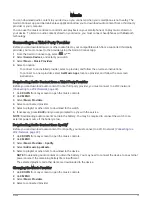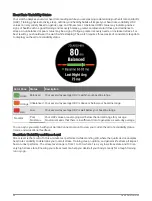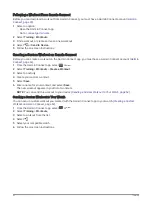
Viewing Your Predicted Race Times
For the most accurate estimate, complete the user profile setup (
Setting Up Your User Profile, page 57
), and set
your maximum heart rate (
Setting Your Heart Rate Zones, page 58
).
Your device uses the VO2 max. estimate (
About VO2 Max. Estimates, page 45
) and your training history to
provide a target race time. The device analyzes several weeks of your training data to refine the race time
estimates.
TIP: If you have more than one Garmin device, you can enable the Physio TrueUp
™
feature, which allows
your device to sync activities, history, and data from other devices (
Syncing Activities and Performance
).
1 From the watch face, select UP or DOWN to view the performance widget.
2 Select MOB to scroll through the performance measurements.
Your projected race times appear for 5K, 10K, half marathon, and marathon distances.
NOTE: The projections may seem inaccurate at first. The device requires a few runs to learn about your
running performance.
About Training Effect
Training Effect measures the impact of an activity on your aerobic and anaerobic fitness. Training Effect
accumulates during the activity. As the activity progresses, the Training Effect value increases. Training Effect
is determined by your user profile information and training history, and heart rate, duration, and intensity of
your activity. There are seven different Training Effect labels to describe the primary benefit of your activity.
Each label is color coded and corresponds to your training load focus (
). Each
feedback phrase, for example, "Highly Impacting VO2 Max." has a corresponding description in your Garmin
Connect activity details.
Aerobic Training Effect uses your heart rate to measure how the accumulated intensity of an exercise affects
your aerobic fitness and indicates if the workout had a maintaining or improving effect on your fitness level.
Your excess post-exercise oxygen consumption (EPOC) accumulated during exercise is mapped to a range of
values that account for your fitness level and training habits. Steady workouts at moderate effort or workouts
involving longer intervals (>180 sec) have a positive impact on your aerobic metabolism and result in an
improved aerobic Training Effect.
Anaerobic Training Effect uses heart rate and speed (or power) to determine how a workout affects your ability
to perform at very high intensity. You receive a value based on the anaerobic contribution to EPOC and the
type of activity. Repeated high-intensity intervals of 10 to 120 seconds have a highly beneficial impact on your
anaerobic capability and result in an improved anaerobic Training Effect.
You can add Aerobic Training Effect and Anaerobic Training Effect as data fields to one of your training screens
to monitor your numbers throughout the activity.
Training Effect Aerobic Benefit
Anaerobic Benefit
From 0.0 to 0.9 No benefit.
No benefit.
From 1.0 to 1.9 Minor benefit.
Minor benefit.
From 2.0 to 2.9 Maintains your aerobic fitness.
Maintains your anaerobic fitness.
From 3.0 to 3.9 Impacts your aerobic fitness.
Impacts your anaerobic fitness.
From 4.0 to 4.9 Highly impacts your aerobic fitness.
Highly impacts your anaerobic fitness.
5.0
Overreaching and potentially harmful without
enough recovery time.
Overreaching and potentially harmful without
enough recovery time.
Training Effect technology is provided and supported by Firstbeat Analytics. For more information, go to
.
Heart Rate Features
47
Содержание QUATIX 6
Страница 1: ...QUATIX 6 Owner sManual ...
Страница 137: ......
Страница 138: ...support garmin com GUID 3D8FCD7B 7C56 43A9 8665 5CDE4FFD7DF3 v4 August 2022 ...
















































